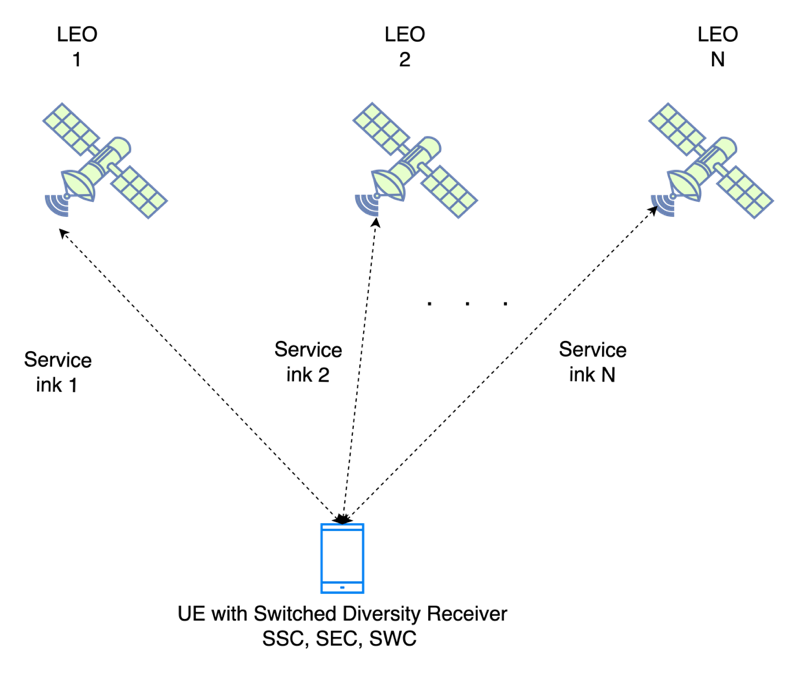
-
StatusOngoing
-
Status date2024-04-18
LEO-DIVE objective is to design, develop and verify via a system testbed (STB) multi-satellite (≥2) diversity technique applicable to large LEO constellations to combat the detrimental effects such as shadowing, multipath fading and channel blockage events. Specifically, the Multi-Satellite Diversity Techniques (MDTs) are expected to improve the achievable peak data rate and the link outage probability at the UTs when at least two satellites are in visibility.
The STB is designed and implemented to exploit the multi-satellite diversity techniques and to test them in various system and channel scenarios, including:
-
Low frequency band scenarios (e.g., S-band) with omni-directional antennas;
-
High frequency band scenarios (e.g., Ka-Band) with high-gain multi-beam ground terminals
The proposed switching diversity techniques are expected to be investigated for both forward (FWD) and return (RTN) links and adapted to the 5G NR NTN specification as proposed by 3GPP (Rel. 17 FR1, and Rel. 18 FR2).

The detrimental effects of the satellite propagation channel (e.g. path loss, atmospheric absorption, Doppler, multipath, shadowing) are well-known to be time, location, and frequency dependent. At the same time, system assumptions like constellation geometry, payload capabilities or frequency reuse schemes increase the scenario variability in which the multi-satellite diversity techniques may operate. Additionally, the diversity techniques for LEO constellations have not been investigated yet in 5G NTN specifications, consequently, the switched-diversity techniques (SDTs) of terrestrial networks cannot be directly applied to LEO satellite communications.
Finally, the signaling of the diversity techniques control and management information in the 5G NTN links with the LEO satellites is also another challenge. Feedback mechanisms (e.g., making use of 5G NTN waveform characteristics) for LEO diversity solutions are investigated by this project’s activities as well as the implementation of proper Channel state information (CSI) mechanisms (either instantaneous or statistical).
The results of the project LEO-DIVE are paramount to large LEO constellations, since they significantly improve the achievable data rate of the UT and reduce the probability of the satellite links to be in outage. Moreover, the project shows how the switched-diversity techniques can be integrated into 5G NR NTN standard.
Extensive state-of-the-art review on switched diversity techniques is conducted, and selection of the most suitable ones are used in large LEO constellations. The work is focused on improving the UT’s achievable data rate and reducing the outage probability, which is assessed through extensive simulations over the proposed STB. The developed STB allows comparative evaluation of the proposed diversity techniques in various system setups and channels and validates the integration of the developed diversity techniques in the 5G NR NTN specification.
LEO-DIVE investigates satellite system architectures implementing switched diversity at UT for low frequency band scenarios (e.g., S-band) with omni-directional antennas and/or high frequency band scenarios (e.g., Ka-Band) with high-gain multi-beam ground terminals. The diversity techniques are assessed for either rural or urban scenarios, and an in-depth analysis is conducted for both transparent and regenerative payloads.
The System TestBed (STB) of LEO-DIVE project is one of the activity core developments. The STB integrates various simulators such as Matlab Satellite Communications Toolbox, Matlab 5G NR Toolbox and open-source ns-3 with proper 5G extensions and provides the following capabilities:
-
Standards-based tools for developing, modelling, and validating satellite communications systems and links are available through the commercial MATLAB/Satellite Communication Toolbox.
-
Functions and reference examples for the modelling, simulation, and verification of 5G NR and 5G-Advanced communications systems that are standard-compliant with the commercial MATLAB/5G NR Toolbox.
-
Open-source ns-3 based simulator with pluggable 5G modules for simulating traffic and for integrating and testing the multi-diversity techniques in a 5G NTN environment.
The proposed architecture can effectively simulate various systems setups for UTs and LEO constellations under the proposed switched diversity techniques. Next, extensive comparisons considering system scenarios not implementing MDT assess the overall improvement of achievable data rate and outage probability both at FWD and RTN links either in low- or high-frequency bands.
The proposed STB is also expected to model the orbital configuration and its effects (e.g. velocity of the satellite and Doppler shifts) together with the selected channel models.



LEO-DIVE involves the following phases:
P1: System Scenarios Definition (reference scenarios, KPI definitions, value proposition, etc.)
P2: Finalised Technical Specification (SOTA, benchmark solution, gap analysis, etc.)
P3: Selected technical Baseline (comparison and trade-off, and selected technical baseline)
P4: Verified Detailed Design (preliminary design baseline, verified detailed design)
P5: Implementation and Verification (demonstrator technical specification, implementation, test, and verification plans)
P6: Technology and Development Plan (technology evaluation and roadmap)
and the following milestones (MS):
MS1: Finalised Technical Specifications & Selected technical Baseline
MS2: Implementation and Verification Plan
MS3: Verified Deliverable Items and Compliance Statement
MS4: Technology Assessment and Development Plan
The flow chart of the study plan presenting the logic of the envisaged work to be undertaken is as follows:

LEO-DIVE started on March 1, 2024. The Work Packages (WPs) expected to be completed during the first six months are as follows:
-
WP1: System Scenarios Definition
-
WP1.1: Reference Operational Scenarios
-
WP1.2 KPI Definition
-
WP1.3: Value Proposition
-
WP1.4 Preliminary Requirements Definition
-
WP2: Technical Specification
-
WP2.1: State-of-the-Art Survey
-
WP2.2: Benchmark Solution and Gap Analysis
-
WP2.3: Finalized Technical Specification
-
WP2.4: Outline Verification Plan




